Serrano peppers are among the most popular spicy chili peppers available. You’ll find them in grocery stores alongside the jalapeño and habanero peppers. The serrano is slender, crisp, and usually sold in its unripe green form.
In this article, you’ll find lots of information about the serrano pepper. This includes the pepper’s origins, flavor profile, heat level, how to grow them from seed, and much more.
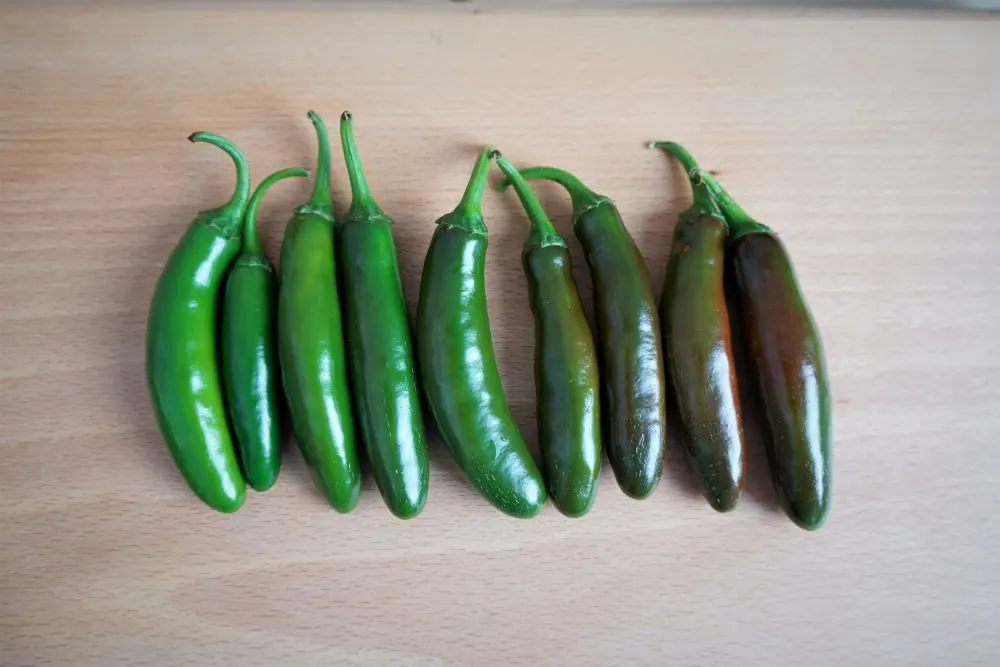
| Name | Serrano |
| Type | Heirloom or hybrid |
| Species | Capsicum annuum |
| Heat Level (Scoville) | 10,000-20,000 SHUs |
| Flavor | Slightly sweet with smoky undertones |
| Color | Dark green to red when ripe |
| Uses | Hot sauces, frying, chili flakes |
| Light | Full sun or afternoon shade |
| Watering | Evenly moist, good drainage |
| Seeds | Botanical Interests or Johnny’s |
In this article (skip ahead):
- Origins
- Serrano vs jalapeño
- Serrano pepper scoville
- Flavor
- Growing serranos
- Why do serranos turn red?
- Saving seeds
- Serrano substitutes
Serrano Pepper Origins
The serrano pepper has historic origins in the mountainous regions of Puebla and Hidalgo, Mexico. The word serrano translates to, “highlander” or “from the mountains.”
Over years of selecting desirable peppers to grow, local farmers improved upon the local pepper varieties. There are several other popular varieties from Mexico as well, most of which come from the Capsicum annuum species.
To this day, Mexico is by far the largest producer of serranos in the world. There are over 35,000 acres of land devoted to their cultivation, with most of the harvests being used fresh rather than processed.
Serrano vs Jalapeño Peppers
Jalapeños appear quite similar to serrano peppers. This makes sense, considering both come from the same species, C. annuum, and both have origins in Mexico.
- Serranos are skinny, jalapeños are wider
- Serranos are typically spicier
- Jalapeños have thicker skin and flesh
- Same Capsicum species
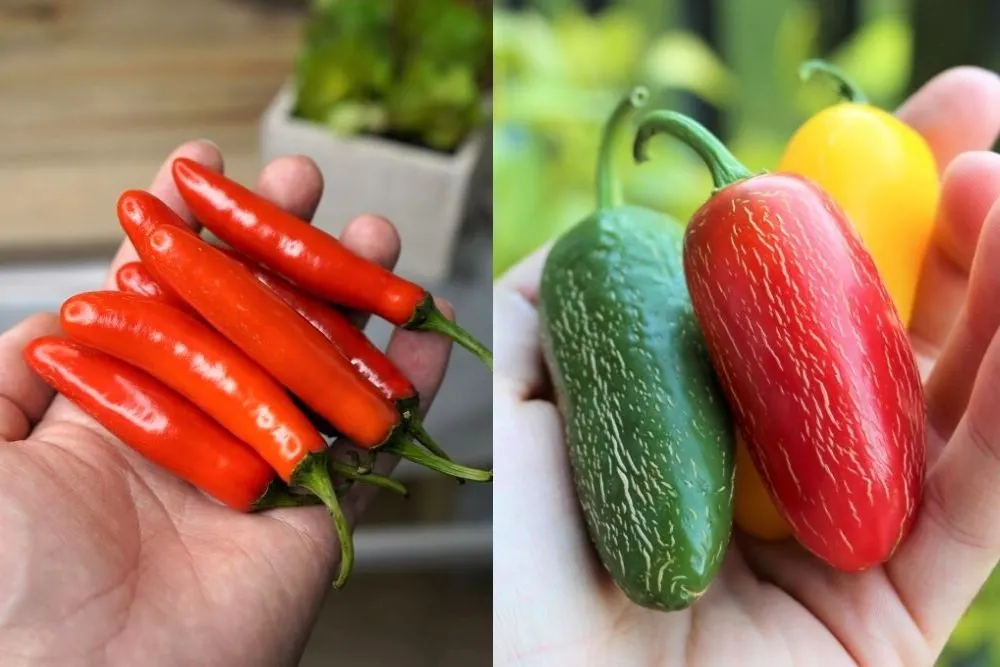
As we can see, the two pepper varieties are quite similar. In terms of flavor, both are slightly vegetal and a bit smoky. They both have a nice crunch when eaten fresh or pickled. They also work as a great substitute for one another in the kitchen!
Get a more in-depth comparison of jalapeños vs serrano peppers here.
Serrano Pepper Scoville Scale (Heat Level)
While serrano peppers may be smaller than jalapeños, that doesn’t mean they are less spicy. In fact, serranos are quite a bit hotter than their close relative!
Simply put, serrano peppers come in at 10,000-20,000 SHUs on the Scoville Scale. This ranks them between a jalapeño and cayenne pepper in terms of heat. For many, serranos offer the perfect heat level without going over the top.
With this powerful kick of heat, serranos are perfect for adding an extra punch to fresh salsas, homemade stir fry, pickled veggies or any other spicy dish. We have also had great success using them in homemade hot sauce for a perfect heat level (and flavor).
Serrano Pepper Flavor
If you are familiar with the flavor of a jalapeño, then you’ll have an idea of the serrano’s taste. It is vegetal, similar to a green bell pepper, with a slight sweetness. It also has a natural smoky flavor that is mild but very pleasant, distinguishing it from sweet varieties.
The crunchy and crisp texture of green serranos is excellent for cooking. They are commonly used in salsa and guacamole, but are also great pickled with carrots and onions. This is commonly referred to “serrenos en escabeche.”
Growing Serrano Peppers
Since serranos have become so popular, many of the latest hybrid varieties are productive, resilient plants. This means you can easily grow your own serrano peppers from seeds in your home garden.
We have saved serrano seeds from store bought peppers and grown them out in our garden. The commercial varieties are typically the most robust and disease-resistant strains, so it could be worth trying this yourself. However, the seeds in store bought peppers will usually produce highly unstable plants, so keep this in mind.
See our recommended growing supplies here.
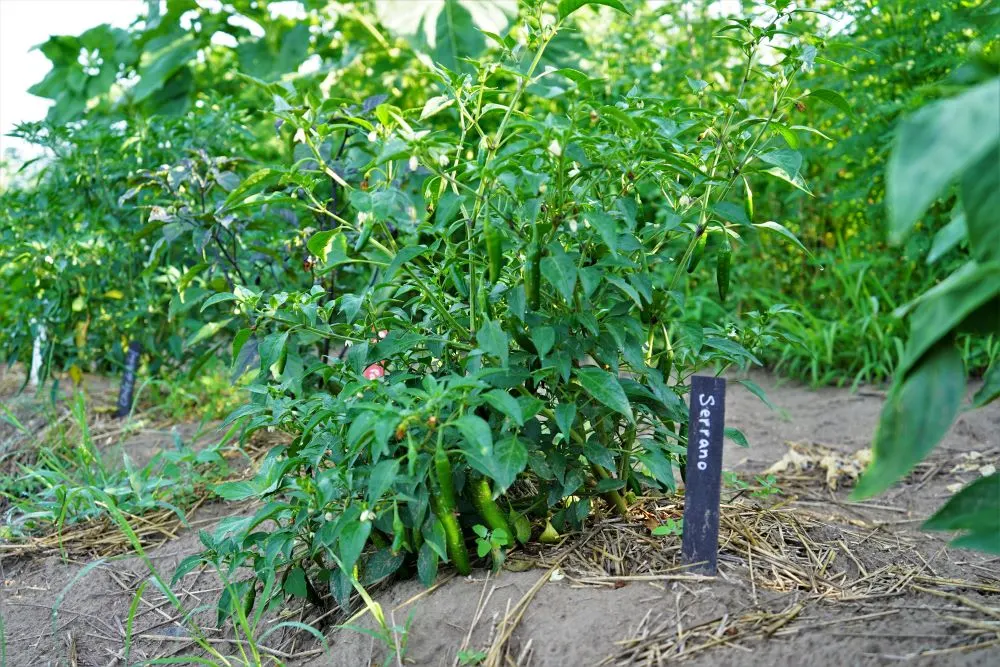
The plants are usually small and bushy, with high productivity and a relatively short maturation period. The leaves are small to medium in size and may be somewhat “hairy” with trichomes. The overall foliage canopy is fairly dense and compact.
Growing serranos from seed (how to):
- Prepare soil. We recommend using a nutrient-free seed starter mix or normal potting soil for planting seeds indoors. Pre-moisten the soil and pack into seed cells for planting.
- Sow seeds and germinate. Plant seeds 1/4″ deep and moisten thoroughly. Cover the seed cells with a humidity dome and keep very warm to initiate germination. Pepper seeds will germinate best at between 80-90°F. We use this seed heating mat and get close to 100% germination rates! Also, be sure you’re planting your pepper seeds at the right time for your location.
- Provide ample lighting. Give your young pepper plants a strong start by providing enough light. We prefer using an LED grow light, and here are a few recommended options if you are in the market. Apply a low-strength (1/4-1/2 strength) fertilizing after 2-3 weeks of growth.
- Transplant. Once the plants have been growing for 3-4 weeks, they are ready to move into larger containers. We typically transplant into 3″ pots before moving into a final planting location. If you used seed starter mix for planting, this is a good time to move into normal potting soil with nutrients added in.
- Move outdoors. Once your last date of frost arrives, you can move your serrano plants outdoors. Be careful to slowly adjust your plants to direct sunlight by gradually hardening them off. Don’t rush this process, or you may risk sun scald or stunted plants.
- Fertilize and water regularly. Young peppers require plenty of nitrogen to produce healthy leaves and stems. You can provide this via compost (ideally) or with natural fertilizer. As for watering, do your best to keep the soil evenly moist at all times, without over-watering.
- Harvest. Once plants are established outdoors, they will begin producing flowers and eventually peppers. At this point, don’t provide too much nitrogen, as this could reduce the number of flowers and fruits that develop. Once the pepper pods are fully grown, they can be harvested. Serranos are commonly picked when they are still green, but can be left to ripen to a vibrant, bright red color for a more sweet flavor.
For a more in-depth grow guide, see our how to grow peppers article here.
How long until I can harvest serranos?
Most serrano plants will produce ripe pods within 70-80 days after transplanting outdoors. By comparison, some superhot peppers can take 120 days or longer to fully ripen.
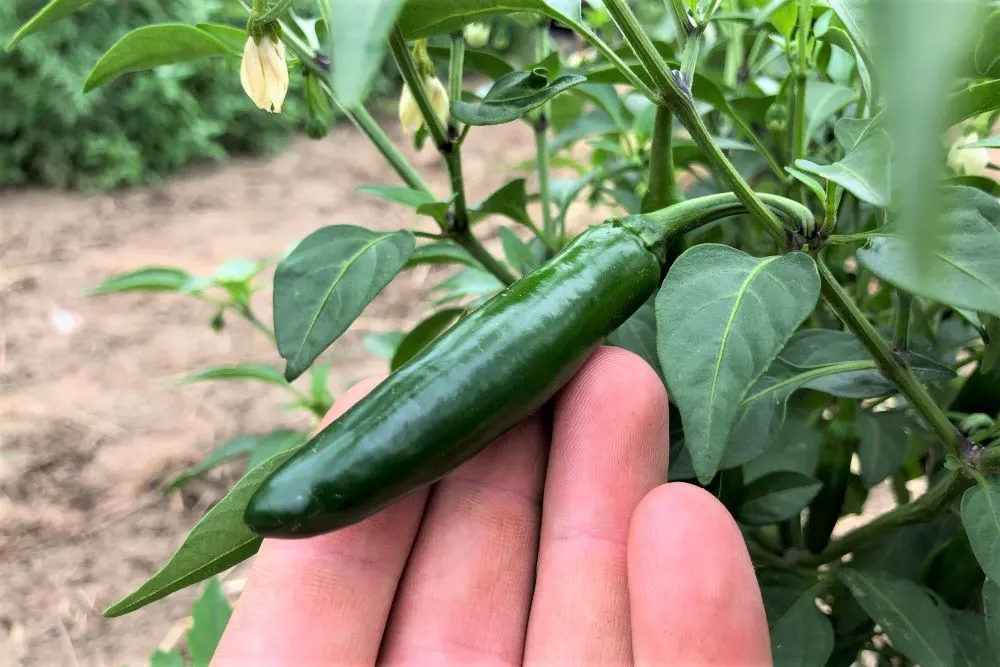
Why Do Serranos Turn Red?
While store bought serranos are almost always a deep green color, they are not fully ripe until they are red. Serranos, as well as jalapeños and bell peppers, turn red when ripened.
The reason for this is perfectly natural – all ripe peppers change color! Most peppers begin as a pale green or yellow, changing to a deeper green, and finally to a ripened color. Most peppers will turn red, but some turn yellow, mustard, brown, orange and even purple!
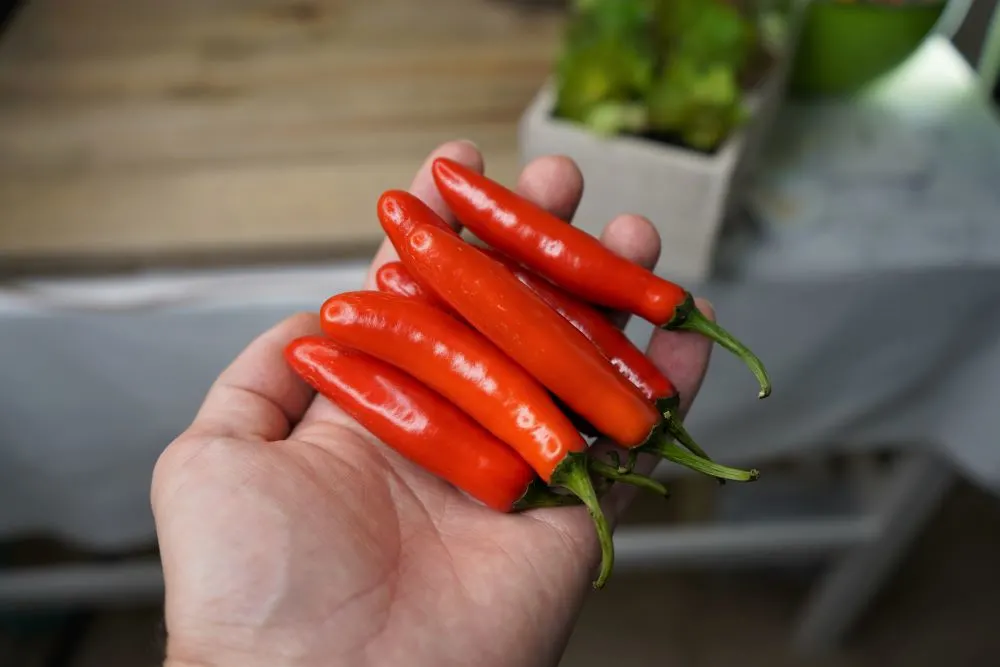
Are red serranos hotter?
Red serranos are typically sweeter and slightly less crisp than green ones, and can sometimes be a bit spicier. The color is not related to the heat level, but the age of the pepper is.
In short, serranos are typically hottest when they are just reaching ripeness, just after turning red. After the pepper ripens, capsaicin production will begin to diminish.
Capsaicin is responsible for the sensation of heat in hot peppers, and is produced continually as a pepper ages on the plant. However, there is evidence that there is a peak window to harvest for the hottest peppers possible.
How to Save Serrano Pepper Seeds
Saving pepper seeds is easy, and it is a great way to save a few bucks. We save seeds from our favorite pepper varieties each year, but only if they are heirloom varieties (not hybrids).
Here is how to save pepper seeds:
- Select ripe peppers. Save seeds from peppers that you find to be ideal. This could mean bigger pods, hotter, tastier, etc. Always choose a fully ripe serrano (let it turn red before picking if possible). This will ensure that the seeds within are fully mature and developed.
- Slice the pepper and remove the seeds. Wearing gloves, slice the serrano lengthwise and use a spoon to scrape out the seeds. You can also rinse the seeds in a fine mesh strainer to remove any of the pepper’s placenta.
- Dry the seeds. Leave the seeds in a single layer on a plate for 5-7 days. Drying times will depend on the air humidity. Aim a small fan at the seeds to speed up the process.
- Store the seeds. Once the seeds are dried, use a paper envelope or small plastic baggie to store the seeds. If storing in an air-tight container, I recommend using desiccant packets to remove any excess moisture.
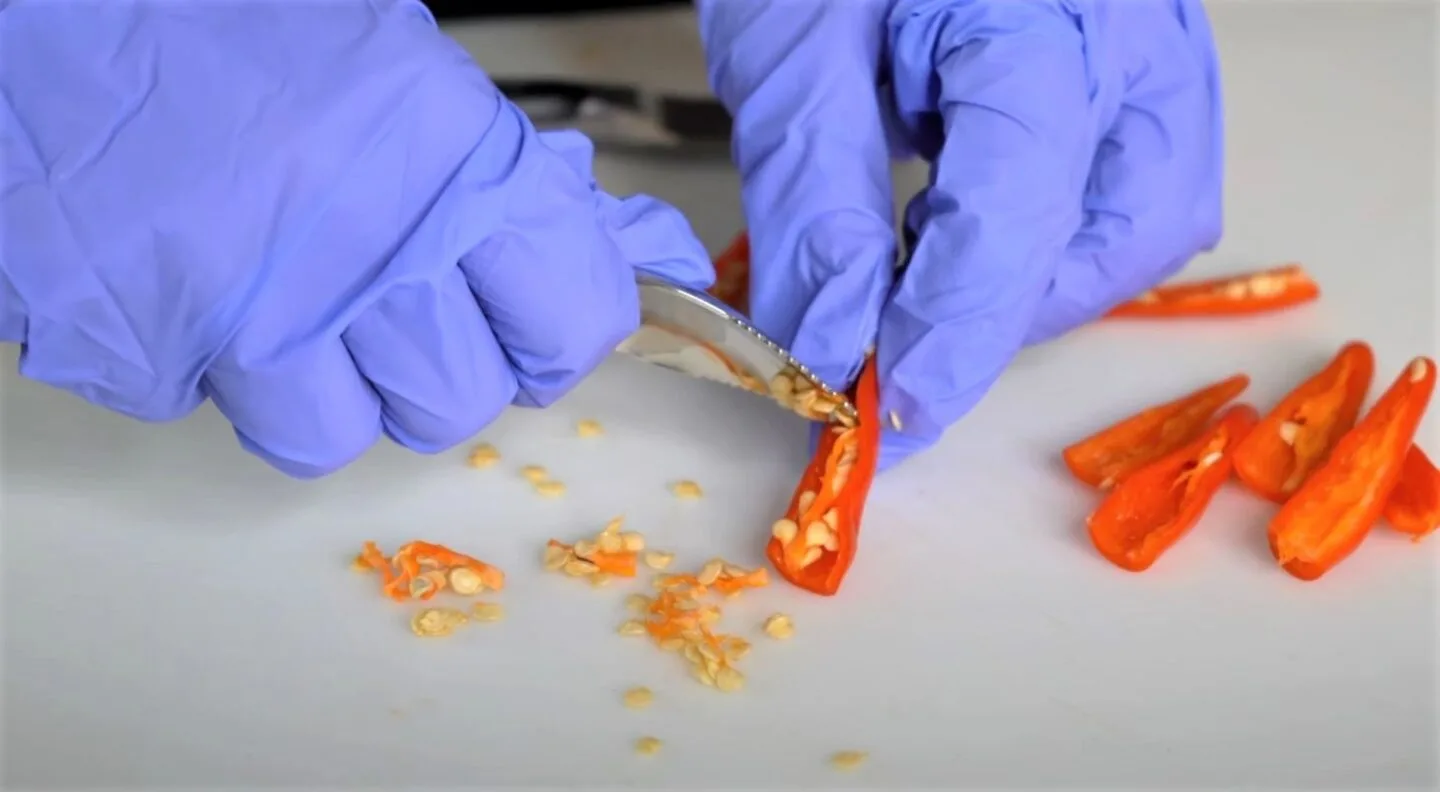
Seeds can keep for years when stored properly. Keep them cool and dry, and out of direct light. We store most of our pepper seed in the refrigerator.
Serrano Pepper Substitutes
When a recipe calls for serranos and you don’t have any, you still have options. Here are a few ideas for how to replace serranos for cooking:
- Jalapeños. A close relative with slightly less heat – great for salsa, guacamole or pico de gallo. Also good if you are making stir fry or something that requires the crunch of the peppers.
- Bell peppers. If you want the texture but not the spice, simply use a sweet bell pepper or similar. Poblanos also have a similar flavor with a much milder heat than serranos.
- Cayenne powder. If heat is all you need, reach for some cayenne pepper powder. Just a pinch or two can add a noticeable warmth to your cooking, so start small! Or, use both bell peppers and cayenne to achieve a similar heat and texture to serranos.
See more serrano alternatives here.
I hope this article helped you learn more about the amazing serrano pepper. We love to grow these versatile little hot peppers in our garden every year. Good luck and happy growing!


rick
Wednesday 29th of March 2023
Great stuff happy to have found your site.
Kevinll
Monday 13th of March 2023
I eat them all the time and they always add that kick to my meals.